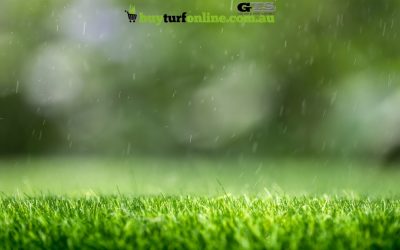How to Level a Lawn in 5 Steps
Quick Links
Levelling Your Lawn
While we know you can always have a perfectly level lawn, having an uneven one may actually cause more problems.
With a smooth surface your soil likely won’t face drainage problems and you’re less likely to scalp your lawn while lowing.
Low spots in your garden, however, make it harder to maintain and can cause waterlogging.
Find out more about why you should maintain a level yard and what might be causing any low spots or holes in the soil.
We also take you through how to level a lawn in 5 steps.
Why A Level Lawn Is Important
There are a few reasons why a smooth, even lawn without bumps or low spots is important. Foremost, it makes your yard more usable and an easier surface for people to walk and play on.
Outdoor activities, such as playing ball or tag, will be safer and more enjoyable for both adults and kids. Having a level yard also helps your grass be healthier and allows for easier maintenance.
Mowing an uneven lawn results in an uneven cut. Not only could you scalp parts of your lawn when you have an uneven yard, but your mower will jump around and it will take longer to mow the entire lawn.
Finally lawn leveling results in a good underground drainage system.
When you have holes and low spots in your soil, water will collect in pools and you have an increased chance of grass disease.
How Do You Get An Uneven Lawn?
While there are many reasons a lawn can become an uneven, bumpy lawn, it’s usually caused by foot traffic from kids or animals, pests such as beetles or waterlogging.
Children
While kids playing in your yard us typically fine, too much foot traffic when the soil is damp or soft can cause it to become uneven ground.
While this means you end up with an uneven lawn, it can also cause compaction in the soil leading to bigger issues.

Animals
Whether it’s your pet or a neighbouring cat, animals are the main cause of holes as well as dead patches of lawn.
They’ll also stray into your garden during vulnerable months when lawns are in hibernation or frosty.
Lawn Pests
Lawn pests such as the larvae of the African Black Beetle, will hatch underground and eat through soil and roots under your grass.
Depending on how much damage they do while they’re in larvae stage, pests are another common cause of a sunken area in your lawn.
Waterlogging
Especially over winter, the weather can play a big part in causing large clumps and bumps in your lawn. Allowing water to build up on the surface of your lawn can cause long-term damage.
Waterlogging is often caused by compacted soil and is worsened by standing water on your lawn.
Tools For Leveling Uneven Lawns
By following our guide on how to level a lawn you’ll need a few key tools including:
- Wheelbarrow or similar container
- A shovel
- Garden rake
- Topdressing (more details in step 2)
You may find that if you are fixing low spots in a larger area, you may need some large equipment to make this task far easier.
However, for the majority of homes, you’ll be able to level a lawn using simple equipment.
Steps For Leveling A Lawn
Step 1: Mow the grass
As part of preparing to level your lawn, you need to be able to see what you’re deaing with.
Have you got a few lumps or bumps, or are there larger holes?
To help you get a better understanding, you should cut your grass blades to the optimal height for your lawn variety, taking care not to scalp the grass.
With that done, you can get a better idea of how much levelling will be needed, and how much lawn leveling mix you will need.
Depending how uneven your existing grass is, you may need a wheelbarrow to transport the top dressing mix and a square-edged shovel.
With your lawn freshly mowed, you will also be able to better identify why your lawn is uneven.

If it is because of foot traffic or compaction, you may find that you need to aerate your grass more often to maintain a level lawn in the future.
However, if it is a more serious issue, such as leaking water pipes, you will find that you’ll be right back at step 1 before long unless the water pipes are fixed first.
Step 2: Water The Grass
Before you level a lawn, you will need to give it a good water.
However, it doesn’t need to be completely drenched, it just needs sufficient moisture a few days before you plan to level your lawn.
For smaller areas of grass, you might find a watering can will be sufficient but larger areas will need a hose pipe.
As want to water evenly but not heavily for this stage, you my wish to use a hose setting with smaller water droplets.
Step 3: Choose & Prepare The Soil Mix For Your Lawn Dressing
The next step is to decide what topsoil mix you’ll be using to level your own lawn.
The most common options for top dressing are sand, topsoil and organic compost.
However, the best option is often a mix of all 3, for example 2 parts sand and 2 parts topsoil with some compost mixed through to make a good soil mix.
While pure sand is often a popular choice, it can be expensive and is only suitable if you don’t already have a sand soil mix.
Sand is easy to use, will attach itself to clay soil and helps with drainage.
Too much, however, will cause drainage issues as the water will drain straight through. This will dry out your soil even if you water regularly.
Using topsoil similar to your existing soil will help to level out your lawn but often won’t help provide much-needed nutrients to your grass.
Compost or an organic soil mixture, however, will give your lawn the nutrients it needs to thrive.
While these each have their benefits individually, a blended top dressing mixture will not only be more cost-effective but will help your grass in more than one way.
Step 4: Tackling Minor Hollows
For any hollows that are less than 2 centimetres deep, simply fill them with your lawn dressing.
Sprinkle a thin layer over the area and brush it into place with a garden rake.
Then, press it firmly into place using the straight side of your rake.
Give the soil a light watering. This will also help to remove air pockets.
If there is grass in the hollow already, make sure to leave the tips poking through the dressing.
However, if you are adding new lawn to a dead spot, you may wish to leave the hole a couple of days before adding the grass.
Step 5: Tackling Bigger Lumps & Bumps
Larger holes or mounds will take a bit more preparation before you can level your lawn.
You’ll need your shovel to cut into the centre of the uneven area, down to a depth of about 5 centimetres.
Then make a second cut at right angles to the first, so you have a cross shape.
Now slide your shovel under each quarter of the cross.
Keep it as flat as you can, and gently fold back the edges of the turf over the surrounding area.
You want to be able to fold these back into place after you’ve dealt with your hollow or mound.

For mounds, dig out any excess soil and then level the soil gently so that it’s flat and you can fold the turf back into place on top.
However, if it’s a hole or an area that’s too low follow a similar procedure to above and fold the grass over. Then remove any large stones or roots and level the soil. Add your new soil mix so that it’s level with the surrounding area.
Give it a rake, so that the surface is even, then fold the turf back into place. Press it down firmly, working from the outer edges to the centre.
Finally, fill any gaps between the cuts with more lawn dressing – or follow our in-depth guide on how to top dress your lawn.
Now all you have to do to level a lawn is wait for the grass to grow and fill in the areas cut, or to grow above the layer of top dressing.
While it will take more than a few days, your grass will have it’s curb appeal back in not time.
Lawn Practices To Maintain A Healthy Lawn
After your hard work levelling your lawn, you’ll want to be able to enjoy it for years to come.
To maintain a healthy green carpet, there are a few simple lawn care practices that will keep your lawn the greenest on the block.
Aerating Your Lawn
Aerating your lawn will help with compacted soil as well as a build up of thatch. Aeration will also help with air circulation, water drainage and nutrient absorption.
Read more about aerating your lawn with a garden fork in our lawn care guide.

Watering Your Lawn
Establishing good watering habits will help your lawn to build up drought resistance and prevent lawn disease. In order to do this, you should water your entire yard deeply and infrequently.
Often, in Australia, you’ll find that you’ll only need to water your lawn when it hasn’t rained recently. And, if you’d like to water your lawn less, you can even use lawn water crystals sprinkled through your grass.
Mowing Your Lawn
Regular mowing doesn’t just keep your lawn looking good, it also encourages even grass growth, stronger roots and faster recovery from disease and pests.
Applying Lawn Fertiliser
Regular mowing doesn’t just keep your lawn looking good, it also encourages even grass growth, stronger roots and faster recovery from disease and pests.
Check out our latest guides on Lawn Fertilisers:

read more!
recent posts
Poolside Turf: Choosing and Maintaining Grass Around Pools
There’s nothing quite like stepping out of a swimming pool onto soft, lush grass. But when it comes to finding the best grass for around a pool, not all lawns are created equal. Chlorine pools, heavy foot traffic, and the unforgiving Australian sun can take a toll on...
Keeping Your Lawn Green and Healthy During the Summer Heat
Discover the best grass options for your lawn with our complete guide. Make informed choices for a lush, healthy yard. Read more to find your ideal grass!
Enhancing Backyard Play Areas for Kids with Turf
Can you put a playset on turf? You bet you can! Natural grass is the perfect surface for creating a safe and fun play area. With the right approach, you can make sure your turf stands up to kids’ adventures while looking great all year round. Let’s explore how to...
Summer Lawn Weeds: Prevention and Management
Discover the best grass options for your lawn with our complete guide. Make informed choices for a lush, healthy yard. Read more to find your ideal grass!

Our Turf
TifTuf Bermuda
Buy Turf Online © 2019 All Rights Reserved. | Proudly Designed and Developed by Sydney ICT




